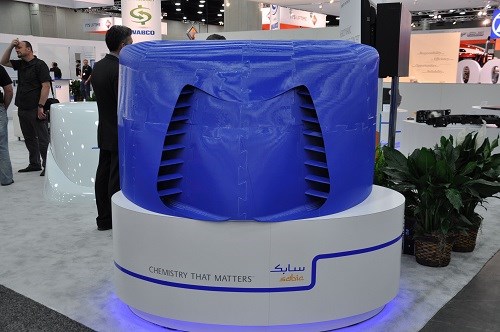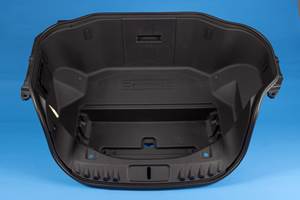Progress Continues on Novel Truck Fairing Concept Design
SABIC's newest thermoplastic truck fairing design concept set to outperform earlier commercial designs.

Tightening fuel efficiency standards for larger trucks both in the U.S. and elsewhere, along with seeking a more environmentally responsible alternative to thermosets without sacrificing performance, has further prompted Pittsfield, Mass., to come up with a novel thermoplastic roof fairing design concept that can potentially reduce fuel consumption of a heavy-duty truck by at least 3%.
Additionally, automotive general manager Scott Fallon says that the new design concept is aerodynamically optimized to deflect air by accelerating airflow through and across the top and sides of the roof fairing. This lead up to 5.9% drop in drag, which significantly improves the aerodynamic performance and fuel efficiency of the truck.
The new design concept incorporates air ducts to reduce front-end pressure and accelerate airflow both over the surface and through the fairing itself. In contrast, conventional roof fairings achieve aerodynamic efficiencies simply by maximizing airflow over smooth, closed surfaces. Fallon believes that through the improved aerodynamic performance of this one application alone, fleet operators stand to save millions of dollars in fuel costs each year and over the lifetime of the entire vehicle fleet.
A large, blue 3D printed version of the company’s aerodynamically-optimized roof fairing was displayed at the Mid-America Trucking Show in Louisville, Kentucky this past March. The timing is crucial as the more stringent fuel efficiency and greenhouse gas emission standards for medium- and heavy-duty trucks beyond model year 2018 are expected to be in place by March 2016.
Just three years ago, the company played a key role in the development of the industry’s first injection-molded thermoplastic roof fairing, which is installed on heavy-duty trucks on the road today. SABIC worked with provider of engineered plastic systems , Montpelier, Ohio, and Volvo Trucks North America. This large component, molded with SABIC’s tough Cycoloy PC/ABS resin and CK Technologies’ proprietary in-mold coating technology, weighs 20-30% less than a comparable thermoset (e.g. SMC).
SABIC recognizes that a range of strategies are needed to meet new tougher efficiency targets. Says, Fallon, “Our lightweight materials can help reduce the overall weight of a truck, but those savings can be easily offset by increased payload capacity so we are finding other ways to help the industry realize fuel economy improvements. This is where thermoplastic-based solutions can be game-changing, thanks to the design freedom they deliver to create unique and intricate aerodynamic surfaces and structures like those found on our roof fairing concept.”
The company used Computational Fluid Dynamics (CFD) simulation technology to evaluate and quantify the aerodynamic performance of its roof fairing concept. Specifically, CFD modeling was applied to compare a baseline day cab with dimensions and geometry representative of top aerodynamically-optimized roof fairing. The CFD data helped reveal opportunities to alter the design for improved airflow and reduced drag.
In a recent update, SABIC sources confirm that further collaboration with the industry on the performance and styling requirements of truck OEMs has led them to pursue additional enhancements to the roof fairing design concept. This includes material selection—with Cycoloy PC/ABS and Noryl GTX PPO included in the running, as well as processing and tooling options.
A preliminary 1;8 scale wind tunnel test has already taken place, with a 30% model scale test scheduled within this year. On-road testing with the EPA—in support of its rule-making initiative for Phase 2 Greenhouse Gas Emissions and Fuel Efficiency Standards for Medium- and Heavy-Duty Vehicles, will take place before year’s end at the Southwest Research Institute in San Antonio, Texas.
Want to find or compare materials data for different resins, grades, or suppliers? Check out Plastics Technology’s Plaspec Global materials database.
Related Content
Automotive Awards Highlight Emerging Technologies
Annual SPE Automotive event gives nods to several ‘firsts’ as well as sustainability.
Read MorePolymer Showdown — PPO vs. PA66: May the Best Material Win
Second in a series, an expert from plastics engineering consultancy The Madison Group pits leading thermoplastics against each other to see how they differ in processing characteristics, chemical resistance, thermal and mechanical performance, and more.
Read MoreGeneral Polymers Thermoplastics to Further Expand Distribution Business
NPE2024: Following the company’s recent partnership buyout, new North American geographic territories are in its sight.
Read MoreAutomotive Awards Highlight ‘Firsts,’ Emerging Technologies
Annual SPE event recognizes sustainability as a major theme.
Read MoreRead Next
Making the Circular Economy a Reality
Driven by brand owner demands and new worldwide legislation, the entire supply chain is working toward the shift to circularity, with some evidence the circular economy has already begun.
Read MoreLead the Conversation, Change the Conversation
Coverage of single-use plastics can be both misleading and demoralizing. Here are 10 tips for changing the perception of the plastics industry at your company and in your community.
Read More












